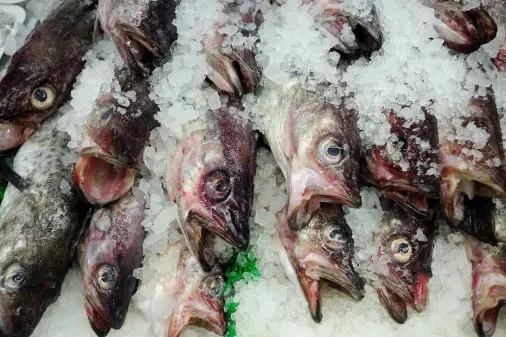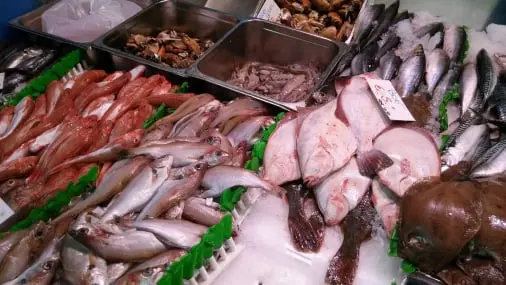Seafood Traceability App:
Seafood Traceability App for seafood packing, seafood storage, seafood quality control. Easy audits & seafood traceability. Recall seafood both up and down supply chains. Minimum seafood waste, maximum seafood traceability & profit.

Seafood Traceability during production & packing
View Traceability App Specifications.
SEAFOOD TRACEABILITY
IQF Seafood packing
A professional business management app for IQF processors and packers of seafood. Contact information of processors, suppliers, manufacturers, specialists, importers, exporters, sales agencies, traders, wholesalers, brands and distributors of IQF Frozen Fish & Seafood Products. Frozen Freshwater Food, Whelk, Scallops, Shrimp, Squid, Octopus, Molluscs, Crab, Cephalopods, Crustaceans and Shellfish.
Seafood traceability and labelling regulations
Seafood traceability and labelling regulations ensure that seafood can be tracked through the supply chain and is described accurately to consumers.
Seafood traceability is the ability to fully trace a product from the point of sale back to its point of origin. This is required to follow general food law, fisheries control and fish marketing.
Anybody placing seafood on the market must label the seafood clearly and accurately. This makes buying seafood easier and safer for the consumer. Seafood labelling regulations are important in maintaining traceability and sustainability within the industry. Seafood is subject to much of the law which all foodstuffs must obey. There are also seafood specific regulations in place.
Traceability and consumer information under EU fisheries control measures and fish marketing requirements (pdf)
Traceability and consumer information for fish landed in Scotland on the fish market: A joint Food Standards Scotland, Marine Scotland and Seafish guidance note
EU Fisheries control regulation lot identification (template)
The Food Information to Consumers (FIC) Regulation - guidance on seafood (pdf)
Glazed Seafood Weight Indication Guidance(pdf)
The Fish Labelling Regulations
Fish traceability requirements
Omega-3 labelling and other claims
Allergen labelling

Seafood packhouse hygiene checklist for food safety
General seafood labelling requirements
Regulation 1169/2011, The Food Information to Consumer Regulation (FIC) becomes effective from 13/12/2014 and replaces the current Food Labelling Regulations 1996.
The new regulation brings EU rules on general and nutrition labelling together into a single regulation to simplify and consolidate existing labelling legislation.
Key changes introduced by this regulation include:
Country of origin/Place of provenance: origin requirements have been tightened and also extended to fresh and frozen meat from pigs, sheep, goats and poultry. Seafood is excluded because an origin in required under the Fish Labelling Regulations.
Nutrition labelling: 'back of pack' information will become mandatory on the majority of prepacked foods, Single ingredient unprocessed foods are exempt eg fish fillets.
Date marking: depending on the type of food, consumers will continue to see 'best before' and 'use by' dates on pre-packed foods. Where appropriate i.e. for meat and fish, there will also be a date of first freezing shown on food labels.
A minimum font size is introduced for the mandatory information on most food labels.
The types of vegetable oil used in food, such as palm oil, must be stated.
Allergen information will be extended to non-prepacked foods and catering situations with flexibility in how businesses provide this to consumers.
Added water in fishery products which have the appearance of being made from a whole fillet will need to be shown in the name of the food if it makes up more than 5% of the final product.
More detail is given on mandatory information that must accompany the name of the food. This includes the use of the words 'formed fish' where a product gives the impression of having been made from a whole piece of fish when it is in fact made from pieces.
Why seafood traceability is so important
Traceability is a catch phrase in the global seafood industry, taken in general to mean the ability to fully trace a product from the point of sale back to its point of origin, with information available about all transactions and movements in between.
But why is this so important? The answer is that traceability is vital for food safety, to prove legality and to verify sustainability. With seafood the most globally traded food commodity, all three aspects are vital, yet there are no international standards related to documentation and record keeping nor to tracking protocols.
Mariah Boyle, project director at sustainable seafood consultancy FishWise, has just completed a white paper on seafood traceability. “Without a Trace: A Summary of Traceability Efforts in the Seafood Industry” points out that issues related to illegal fishing and mislabelling have become more prominent in recent years, as NGOs and governments make efforts to combat them. Media interest has also brought concerns to fore.

Seafood Traceability management best practices
“For seafood traders, the lack of product origin information and supply chain transparency can pose significant risks and have far reaching and unforeseen effects,” explained Boyle. “In the past, the focus has been primarily on food-safety concerns, but media coverage has highlighted wider environmental, social and legal issues associated with seafood. This has raised significant shareholder concerns, which can impact brand value and question the corporate social responsibility initiatives of companies.”
Mariah finds that opportunities for fraud are increasing as new and poorly managed fisheries develop, resulting in traders being unable to track the origin of products, or to verify they are the actual species being sold. Of particular concern to her are the human rights issues frequently associated with illegal fishing activities.
“I want my research to spark debate as to how the seafood industry can work together to eliminate illegal fishing and unacceptable social conditions from supply chains. If government, conservation organizations, funders and industry work together, significant progress on seafood traceability can be made, and, in turn, the environmental and social aspects of the seafood industry improved,” Boyle told SeafoodSource.
The paper gives an overview of traceability and the importance of traceability systems, looks at the challenges and explores how more than 40 international and regional government programs, certification systems, conservation organizations, companies and industry groups are tackling traceability issues.
Challenges to making seafood fully traceable through use of a standardized electronic system throughout the supply chain include language and technological barriers and the cost implication for smaller companies. “The industry has grown up on long-term relationships and trust, and with supply chain information closely guarded,” said Boyle. “Those still operating such systems fear that transparency will lead to breaches of commercial confidentiality, allowing the information to be used to others’ advantage.”
However, progress is being made, with DNA testing and traceability software being developed and companies instituting traceability policies with the help of NGOs, government bodies and technology companies.
“The process has started, but much more work needs to be done,” she said. “Companies and organisations can also encourage countries to adopt the UN Port State Measures Agreement, work with developing nations to help them prevent IUU fishing in their waters, and ensure that government and industry work together on effective and efficient traceability systems.”

Seafood Supplier Traceability Management
Boyle wants the white paper to serve as a guide for seafood businesses seeking to improve the traceability of their own supply chain and to build the knowledge base of NGOs and other groups working on seafood traceability.
She recommends a series of simple steps to help companies improve the traceability of their supply chain, including communicating their expectations to suppliers, improving internal tracking systems, conducting risk assessments, auditing high risk items and ensuring database systems are configured to receive and store pertinent details.
A second version of the document is due to be released in late August.
Seafood traceability is critical to strengthening sustainable fisheries management, deterring illegal practices, verifying environmental and social responsibility claims, and allowing Canadians to support local, sustainable seafood producers.
Consumers increasingly want to know if their seafood choices are environmentally responsible, as well as legally and ethically produced. Today, most businesses cannot answer these basic questions because they do not trace products from water to plate except for basic food safety information. And those who have more sustainable and socially responsible practises can’t get the benefits they deserve.
To solve this problem, companies use different processes and technologies to collect information about the products they buy and sell. There are varying levels at which industry can implement a tool called “traceability”. Traceability is the ability to access information about a product throughout its supply chain by way of recorded identification.
Some seafood products are relatively easy to trace, but others can be much more complicated. Consider a vessel in the British Columbia trawl fleet that has two types of fishing gear (mid-water and bottom trawls) and regularly catches 20 species of fish. Maintaining traceability through the landing, processing and distribution steps is exceptionally challenging. However, traceability for all seafood sold is key to ensuring information about the product moves from harvest to plate.
This is a simplified illustration of a seafood supply chain. Traceability is required to maintain information through every step in the process.
This is a simplified illustration of a seafood supply chain. Traceability is required to maintain information through every step in the process. Click to enlarge.
While there are different types of traceability systems, to be effective, they must:
Start collecting and maintain data at the point of harvest
Use a label or other identifier physically attached to the product that traces what it is, where it came from, and how it was produced, as well as its movement throughout the supply chain
Maintain records and processes that make data shareable and accessible, within and across businesses and governments as appropriate
Include independent verification
With effective traceability, businesses can verify the environmental sustainability and social responsibility of products they purchase. Companies and investors can be protected from regulatory and reputational risks. Producers and suppliers who maintain sustainable practices can get the recognition they have earned, and governments can better manage their resources.
For years, SeaChoice and other organizations have advocated for stronger traceability within the seafood supply chain. From 2017-2019 we engaged in federal food policy consultations, submitting recommendations for how Canada’s regulatory requirements could be more robust. For more information on how SeaChoice thinks Canada should implement stronger traceability requirements see our contributions to the Safe Food for Canadians Regulations and Food Labelling Modernization Initiative. We also garnered support from 3,200 Canadians who agreed to #JoinTheShift in the fall of 2018 by signing a letter asking their retailers to source local, traceable, properly labelled fish.
In recognition of the importance of traceability for producers, distributors, retailers and consumers, the Federal government committed in 2019 to implementing a boat-to-plate traceability program for seafood sold in Canada. SeaChoice is working to make sure they deliver on that promise. Our recent petition garnered over 5,600 signatures from engaged consumers who want to see proper seafood traceability implemented.
Sign up for our newsletter at the bottom of this page to be kept informed on how you can support the government’s promise going forward.
Our Work on Improving Traceability of Seafood in the Supply Chain
SeaChoice and its partner organizations are working on various projects to improve seafood traceability.
At an operational level, we are working with the BC trawl sector and KnowYour.Fish, a traceability platform developed by Vericatch. Although the platform has been functional since 2019, it has not been widely adopted. We continue to work with the supply chain and retailers to procure fish from this fishery and ultimately label products with the detailed information that is maintained with each fish.
SeaChoice is actively involved in initiatives for improved seafood traceability globally, such as the Global Dialogue for Seafood Traceability (GDST), a business-to-business platform advancing interoperable seafood traceability internationally.
SeaChoice is working with retailers toward voluntary improvements of labelling and traceability best practices.
One way we are monitoring voluntary improvements is through our Canada-wide index on seafood labelling accuracy and quality by major retailers. We are also motivating voluntary improvements through Seafood Progress – SeaChoice’s online resource for consumers to find out what Canada’s largest retailers are doing to support sustainable seafood.